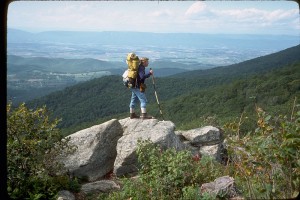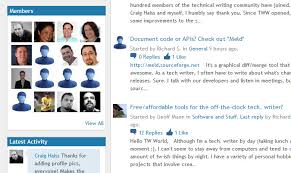An Awesome Web Community
Posted on April 20, 2016
Filed Under Communication, Technology, The Writing Life | Leave a Comment
We need to tip our hat, or maybe more, to Technical Writing World, the “social network for technical communicators.” Yes, more – so we’ll blog a bit about the site. Why? Because it’s got over 2,800 members, and that’s great for a social network that’s not Facebook or Twitter.
What’s all this gushing about? Well, we’re halfway through our second reading of Mark Schaefer’s latest book, “The Content Code,” which describes in detail how hard it is to get discovered on the Web these days, and how it’s getting even harder.
What Technical Writing World’s impressive membership indicates is that technical writers are discovering each other in a world-wide community of engaged, conscientious people. We knew they were conscientious, of course, but to join and sustain a worldwide community like TWW is exemplary these days.
For the Web is like a vast sea that’s getting ever wider and deeper, one where it’s increasingly hard to be found and engage with other colleagues. We look at Technical Writing World and all sorts of sharing seems to be occurring there. There are 189 blog posts, 607 forum discussions, an upcoming event next month of the Society for Technical Communication, leaderboards to promote the most active members and their contributions, a Techcomm Superfeed with the latest blog posts from members, and postings of technical writing jobs. (Might this be a special reason for the site’s popularity?)
“I’ve spent the last year studying this essential concept of content ignition, Mark Schaefer writes in ‘The Content Code,’ and it has changed me. There is a science and psychology behind the act of sharing content that is awe-inspiring and beautiful and mesmerizing. People share content for hundreds of reasons, but there is a uniform process behind it inexorably linked to self-image, caring for others, and even compassion for an author or brand.”
Well, nobody seems in need of compassion on “Technical Writing World,” but it is indeed an awe-inspiring site, a testimony to the communal challenge, satisfaction and sharing behind technical writing taken seriously and collegially. – Doug Bedell
Ready, Write, Aim – No, That’s Not It
Posted on April 8, 2016
Filed Under Communication, The Writing Life | Leave a Comment

What’s the most important element in starting a technical writing task? (Or any other, for that matter.) Why, it’s your aim, of course. “What am I trying to accomplish with this? Where are we headed?” Putting first things first requires that you have a good fix on what you’re aiming for before you start doing it.
Don’t be the kind of writer who just tries to fill space – that won’t have a worthwhile outcome. We used to do editorial writing, with a wide column of empty space to be filled daily. But filling that space wasn’t, or shouldn’t have been, our aim. Having something to say was what benefitted readers, sharpened their perceptions and expectations of us. That was, or should have been, our real aim.
Such thoughts occurred (again) while reading Neal Caplan’s post “…You’re Not Good Enough.” Being judged by other people’s standards is okay, so long as you all have the same aim. But if you don’t, watch out. You may get to where they’re headed and find, pretty quickly, that it’s not where you need to be. It’s all in your aim.
Taking careful aim shouldn’t be any different for technical writers than anyone else. What in the way of writing crisp, efficient documentation should be your intent on behalf of those who will be using it? Don’t just start spieling out directions. They may get pretty roundabout.
“As nice as it is to hold a copy of a book that you wrote,” Neal notes, “it’s not so nice to tell your customers that they MUST read that book before they can use your product. Or, more likely, that shelf full of books. This is the opposite of ‘just in time’ help: it’s ‘become an expert on this product before you ever think about touching the UI.’”
Your aim isn’t to help colleagues become expert at what you’re doing, but to become better at what they’re trying to accomplish. There’s always more to discover, learn and know. The real question is: to what end? What are you aiming for, organizationally and individually? Keep focused on that; it’s what matters most. – Doug Bedell
Getting ‘Out There’ Matters Greatly
Posted on March 11, 2016
Filed Under Technology, The Writing Life | Leave a Comment

On his ‘I’d Rather Be Writing’ blog, Tom Johnson in California’s San Francisco Bay area takes the occasion of moving to a new job to reflect on what he was pleased with, and not so pleased with, on his old one. His reflections reveal a conscientious, fully engaged technical writing style, although not a perfect one – on his old job, anyway.
Tom’s first priority, a key resolve, seems to be getting out to where the work is done, to experience what’s happening before he prescribes procedures to keep it happening.
“Understanding the scrum process and how it was implemented,” Tom notes, “allowed me to quickly understand what teams were working on and what documentation needed to be written or updated, and when.”
Like a street-side reporter, you have to be on the street, rather than at your keyboard, to experience what’s actually happening before you start to describe it for others. There’s nothing like “being there” as a first step.
“I like being a part of engineering teams,” Tom notes, “embedded right there alongside product managers, quality assurance engineers, and developers. I built a strong sense of trust and rapport with the teams. I don’t like it when writers are grouped in their own space and interact mostly with each other, separated from the engineers.”
In getting to know the engineers he’s writing for, Tom is almost automatically in closer touch with them – they’re colleagues, not clients in their own “spaces”.
“I learned,” Tom confides, “that you should never send blanket emails to the entire team asking for reviews of massive amounts of documentation, because it will never happen.”
His goals for next time include trusting nothing, testing everything; keeping documentation systems as simple as possible and “diving deep into content, not doc tools.”
This all gets down to becoming, and remaining, authentic in your approach to technical writing. It may seem initially comfortable to be sitting at a wide display with a slick keyboard, but, over time, it’s the content, more than the technique that matters. And you get that from your colleagues. After all, they’re doing the work you’re describing. – Doug Bedell
Bless Her, Sarah’s All For Sharing
Posted on March 6, 2016
Filed Under Technology, The Writing Life | Leave a Comment
Cheers to Sarah Maddox for taking us (virtually) to the TCWorld India 2016 conference held recently in Bangalore. “It’s been an amazing, rewarding experience,” Sarah, writer of the Ffeathers technical writing and fiction (there’s a combination) blog, notes. “Here are some of my impressions, and a roundup of the posts I’ve written about the sessions I attended.”
 What follows from Sarah, who’s from Sydney, Australia, is the next best thing to being at the conference, photos of the event but more to the point, her notes on the sessions she attended. These include topics like “The Future *I* Technical Communication”, which was Sarah’s keynote to the meeting, with 71 slides.
What follows from Sarah, who’s from Sydney, Australia, is the next best thing to being at the conference, photos of the event but more to the point, her notes on the sessions she attended. These include topics like “The Future *I* Technical Communication”, which was Sarah’s keynote to the meeting, with 71 slides.
There’s easily a week’s material on technical writing here, all from an energetic, community-minded woman who enjoys sharing her insights, big time. Thanks Sarah!
The photo, of a dance party at the conference, shows that everybody had a great time learning! – Doug Bedell
Improving Toward a Summit – a Constant Process
Posted on February 25, 2016
Filed Under Technology, The Writing Life | Leave a Comment
What’s “done” in terms of technical resources these days? Probably nothing, at least in the realm of process and methodology. Both are open-ended and need to be so to allow for improvement, for adding new features and reaching higher, more refined “ends”.
 Process improvement is actually an endless process. It needs to be conducted as though an “ending” is beside the point. A pause for evaluation and insight, yes. An ending, no, not if you’re steadfastly open to learning and improvement.
Process improvement is actually an endless process. It needs to be conducted as though an “ending” is beside the point. A pause for evaluation and insight, yes. An ending, no, not if you’re steadfastly open to learning and improvement.
What’s prompted these advisory reflections? This time, a post on Technically Speaking by Rick Stewart headed “Modern Software Development: A Continuous Journey, Not A Delivery Destination.”
“But I’m not into software,” you say? “Everything needs to have a finished state.” No, it doesn’t, and shouldn’t. Software aside, there’s a better way to brew a cup of coffee, not one you’d want to come upon every day, but a new bean or filter that makes an appreciable difference. You don’t want to go back to the old way of brewing now that you have this new cupful in hand. Life’s ever-unfolding promise is demonstrated anew.
Rick Stewart could learn more about writing. His paragraphs are too long and unwieldy. But the insights are there nonetheless. The words were worth spilling out, now they’re well worth improving upon.
Rick is writing about hiking in the Shenandoah National Park to a “spectacular summit”. It was a lot of fun for his family and friends with great views along the way. Why expect readers to plow through dense paragraphs to get there themselves?
The lesson in all this is to ask a constant question: Have I done this well-enough or really well? Well-enough may be okay for today, really well is a lifelong aim. – Doug Bedell
Technical Writing Is Like Other Writing Done Well
Posted on February 16, 2016
Filed Under Communication, Technology, The Writing Life | Leave a Comment
What is this craft of technical writing that we’re engaged in? And why should we be fussing with a question like this? Instead of defining our activity, why don’t we just settle down and do it?
 Well, you’re right, we could just get on with it. But definitions, even for words or activities we know well (don’t we?), are useful. They bring clarity and may remind us of aspects of a task that we’ve overlooked or would rather not be reminded of.
Well, you’re right, we could just get on with it. But definitions, even for words or activities we know well (don’t we?), are useful. They bring clarity and may remind us of aspects of a task that we’ve overlooked or would rather not be reminded of.
TechWhirl responds to this question with a simple, three-word phrase. (See, if you get serious about something, you can simplify it.) Technical writing is “simplifying the complex.” Yes, that’s simple enough, but is it truly enough? When you head over to Oxford Dictionaries Online, four definitions are provided for the word technical alone.
TechWhirl notes that the U.S. Bureau of Labor Statistics “defines technical writers as those who ‘…put technical information into easily understandable language.'” That’s simple and direct enough, especially for a government agency.
Yet maybe we should note TechWhirl’s long-form definition: “Good technical writing results in relevant, useful and accurate information geared to specifically targeted audiences in order to enable a set of actions on the part of the audience in pursuit of a defined goal.”
That whopper hinges on instructional audiences and their goals – presumably, accomplishing a critical task efficiently and safely. To act efficiently and safely, you need instructions that are clearly written and presented, along with being accurate.
Simple enough, right? Yes, but first, you need to be a master of the process in question to write about it authoritatively and efficiently. Not just the process, but, equally important, the context in which it’s being applied. (We keep thinking back to our years spent working in nuclear power plants.)
TechWhirl discusses a number of other elements, but they’re mainly on the order of fine-tuning. The essence of the matter is that a good technical writer needs to be authoritative and focused on his reader in pursuit of a common goal – accomplishing a task efficiently and safely. That, incidentally, is how Hemingway might have described his writing as well. It’s all a matter of context and being effectively other-focused.
(The graphic above is from a LinkedIn SlideShare presentation by Muhammad Ilyas.) – Doug Bedell
Clarity In Progress
Posted on January 31, 2016
Filed Under Business, Communication, Technology, The Writing Life | Leave a Comment

Who would disagree that the biggest issue in technical writing “is the inability to see simplicity in complexity.” If you’re trying to reach even a veteran engineer with guidance or instructions on a new procedure or process, you want to be as direct as the process allows.
We thank Mark Crawford on the ASME.org site for discussing this question of simplicity in complexity via his “How Engineers Can Improve Technical Writing” post. It’s been out there a few years now but, as we suspect may be true of other colleagues, we’ve just caught up with it in the Internet’s vastness.
To write with clarity and directness requires that you understand a technical situation as fully as your capacities allow. We assume you wouldn’t be writing about such challenging material if you weren’t qualified to do so. The issue isn’t technical competence so much as communication prowess. You need to describe a process clearly and competently. When you think you’ve finished, the test is, Have you communicated well?
“After all,” Crawford adds, “technical writing is not just about language skills – it’s about how we think.” Indeed. Clear writing requires clear thinking. And that’s as much a communication issue as a technical one. You can’t communicate well if your thinking is garbled at the gate.
So before plunging into a process, take time to review it first. What is it intended to accomplish? How can a reader/user get there promptly, clearly and safely? Simple sounding, yes, but not so simple in practice. Often we’re too rushed, or feel so, to
organize, settle down and produce a clearly described series of steps to get there as intended. – Doug Bedell
For Fresh New Insights, Take a Walk
Posted on November 21, 2015
Filed Under The Writing Life | Leave a Comment
Are you stuck? Need a new concept? Go take a walk, a nice long one. That’s what Sarah Maddox does when she needs a change of mental scenery.
These days, we should have realized, when you’re out walking and come up with welcome new insights, you can scribble them on a piece of paper, or better yet, send yourself emails on your cellphone, “sometimes a series of them.”
 “Make sure,” Sarah adds on her Ffeathers blog, that “you capture the actual words of your thoughts, because they encapsulate the insight that you’ve come to.” Faced with appearing before a group, Sarah found she had virtually a whole new presentation after one of her walks. “It’s a bit like those fictional characters who take a story in directions the author hadn’t originally designed.”
“Make sure,” Sarah adds on her Ffeathers blog, that “you capture the actual words of your thoughts, because they encapsulate the insight that you’ve come to.” Faced with appearing before a group, Sarah found she had virtually a whole new presentation after one of her walks. “It’s a bit like those fictional characters who take a story in directions the author hadn’t originally designed.”
And are they welcome!
“I went for a walk,” Sarah elaborates, “watched the birds, admired the budding trees, wrote myself some emails. The end result was that I removed the worrisome section and integrated some of it into the rest of the presentation. The entire concept of the document had developed and moved beyond its erstwhile centre piece.”
A bit like “the breeze and I” getting work done together, we’d say. Taking a walk probably will beat switching on a football game or doing something else in your home office setting to open new streams of insight, or recover helpful recollections. Our minds, after all, are connected to our eyes, feelings and muscles to prompt an entire insight-generating system to change course.
That’s our aim, anyway. Thanks for the suggestion, Sarah. I’m going out for a walk. – Doug Bedell
(The photo was taken by Sarah Maddox at Snoqualmie Falls, near Seattle WA, presumably on one of her walks.)
Technical Writers Connect With Needs, Solutions
Posted on November 9, 2015
Filed Under Communication, The Writing Life | Leave a Comment
Technical writers, you’ll be pleased to know, aren’t just scribblers. In their full professional regalia, they’re connectors, too. That’s a point made by Bart D. Leahy on his Heroic Technical Writing blog, which, by the way, has a Superman header. (After all, Clark Kent was a reporter.)
 On their rounds, technical writers spot needs or frequently will be introduced to people with special abilities. If they take note of the skills of such specialists, they’ll be in a position to connect them to someone who, further along the way, might be able to consult with them.
On their rounds, technical writers spot needs or frequently will be introduced to people with special abilities. If they take note of the skills of such specialists, they’ll be in a position to connect them to someone who, further along the way, might be able to consult with them.
Leahy notes that Malcolm Gladwell describes such linkups in his book, The Tipping Point. “Connectors,” says Gladwell, “are the people in a community who know large numbers of people and who are in the habit of making introductions. A connector is essentially the social equivalent of a computer network hub…”
Yes, technical writers often find themselves at the heart of the action. They need to sort through what’s occurring and, in that guise, might well make recommendations on how to improve the situation. In such instances, previously established contacts and accumulated insights are among their assets.
If not supermen, technical writers are knowledge hubs as well as scribes. “If you know what types of things other people know,” Leahy points out, “you can leverage that network when you have a question about certain topics. Or, conversely, if you find something of interest to someone who has particular interests, you can connect them with something or someone of interest to them later.”
So, technical writers are like circuit riders, or knowledge carriers. Don’t ever view them, the likes of Encore’s Dennis Owen, as drudges. That could cost you contacts and solutions. – Doug Bedell
Purdue’s Online Lab: A Good Place to Approach Technical Writing
Posted on October 26, 2015
Filed Under Communication, The Writing Life | Leave a Comment
Purdue University’s Online Writing Lab (OWL) provides virtually an online course in technical writing, free of any “charge” except for rapt attention. “These OWL resources,” says the site, “will help you conduct research and compose documents for the workplace, such as memoranda and business letters. This section also includes resources for writing report and scientific abstracts – pretty close to the definition of technical writing.
This isn’t to say, of course, that simply by scanning Purdue’s online materials you’ll become a practiced technical writer. Practice itself, preceded by an aim and sense of purpose and audience, is virtually the key to effective technical writing. But since technical writing is also orderly writing, Purdue’s Writing Lab, it appears, can be of great start-up help.
Founded as a land-grant college, Purdue evolved into a collegiate powerhouse, and not just in football. In 1891, it “acquired a working railroad engine to mount in a newly established locomotive laboratory. It was one more step in the development of Purdue as one of the world’s leaders in engineering teaching and research.”
So spend some time at Purdue’s Online Writing Lab. There’s a proud academic tradition behind it, a polished working-level, technically astute view of the world. On Boilermakers! – Doug Bedell
« go back — keep looking »Recently
- Presentations With Forethought
- Technical Writing’s Lineage – Surely It’s Deeper than Digital
- At the Holidays, Twitting Amazon
- Successful Cookie Baking – From Mom, an Acknowledged Expert
- Slides for a Tech Writer’s Craft
- Digital or Not, Be Clear
- Being Watchful About Digital Designs…
- When Proposals Don’t Click, Keep Making Them Anyway
- Like a Good Gardener, Help an Enterprise Keep Itself Current
- We’re Leaders All, And Need to Think That Way
Categories
Archives
- January 2017
- December 2016
- November 2016
- October 2016
- September 2016
- August 2016
- July 2016
- June 2016
- May 2016
- April 2016
- March 2016
- February 2016
- January 2016
- December 2015
- November 2015
- October 2015
- September 2015
- August 2015
- July 2015
- June 2015
- May 2015
- April 2015
- March 2015
- February 2015
- January 2015
- December 2014
- November 2014
- October 2014
- March 2014
- February 2014
- January 2014
- December 2013
- November 2013
- October 2013
- September 2013
- August 2013
- July 2013
- June 2013
- May 2013
- April 2013
- March 2013
- February 2013
- January 2013
- December 2012
- November 2012
- October 2012
- September 2012
- August 2012
- July 2012
- June 2012
- May 2012
- April 2012
- March 2012
- February 2012
- January 2012
- December 2011
- November 2011
- October 2011
- September 2011
- August 2011
- July 2011
- June 2011
- May 2011
- April 2011
- March 2011
- February 2011
- January 2011
- December 2010
- November 2010
- October 2010
- September 2010
- August 2010
- July 2010
- June 2010
- May 2010
- April 2010
- March 2010
- February 2010
- January 2010

